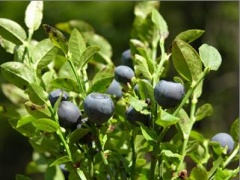Huckleberry
| Infobox on Huckleberry | |
|---|---|
| Example of Huckleberry |  |
| Facts | |
| Origin | - |
| Stowage factor (in m3/t) | - |
| Humidity / moisture | - |
| Ventilation | - |
| Risk factors | See text |
Huckleberry
Contents
Description / Shipment / Storage / Risk factors
Scientific Name and Introduction
Vaccinium ovatum. Huckleberry is native to the Western coast in areas from northern California to British Columbia. Vaccinium is the ancient Latin name for blueberry, and the specific epithet ‘ovatum’ refers to the oval leaf shape of this species.
Quality Characteristics and Criteria
Harvest branches when fully mature, without soft tips. This species is very long lasting with few postharvest problems. Thus, if it looks good at time of purchase it should perform well.
Grading and Bunching
N.a.
Ethylene Sensitivity
Huckleberry is not sensitive to ethylene.
Pretreatments
No pretreatments are required for huckleberry.
Storage Conditions
Huckleberry can be stored for extended periods by enclosing pre-cooled bunches in a plastic vapour barrier and holding them near 0ºC.
Special Considerations
Watch for excessive storage as depicted by fungal growth (fuzziness), and watersoaked or discoloured leaves. Their woody stems sometimes make it difficult to re-cut. Re-cutting this species is less critical than for other floral crops.
Sources used
BMT Consolidated Manual on (Dutch) Flower Bulbs, cut flowers/greens and potted plants.











